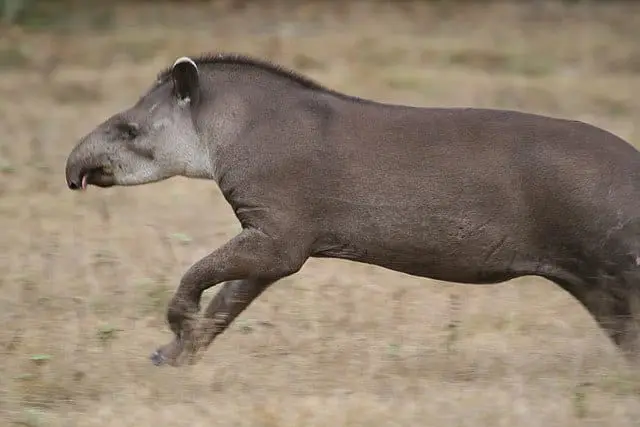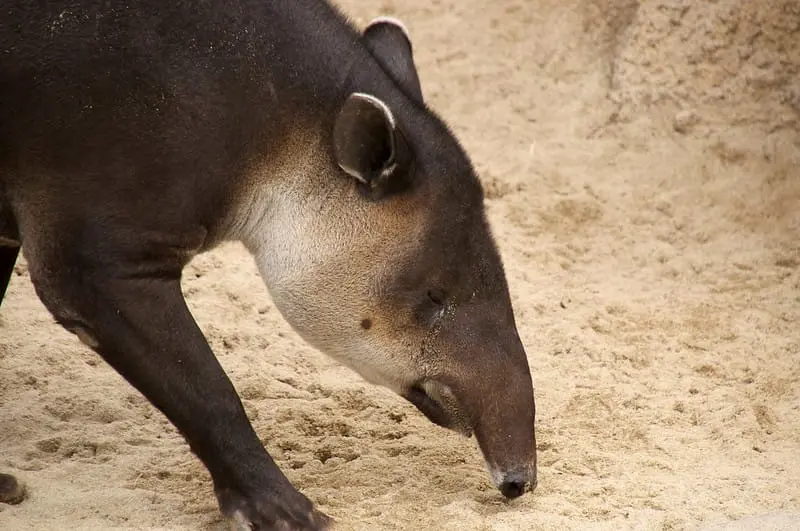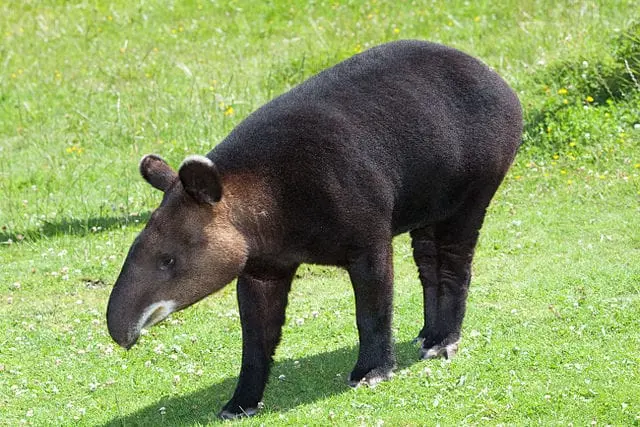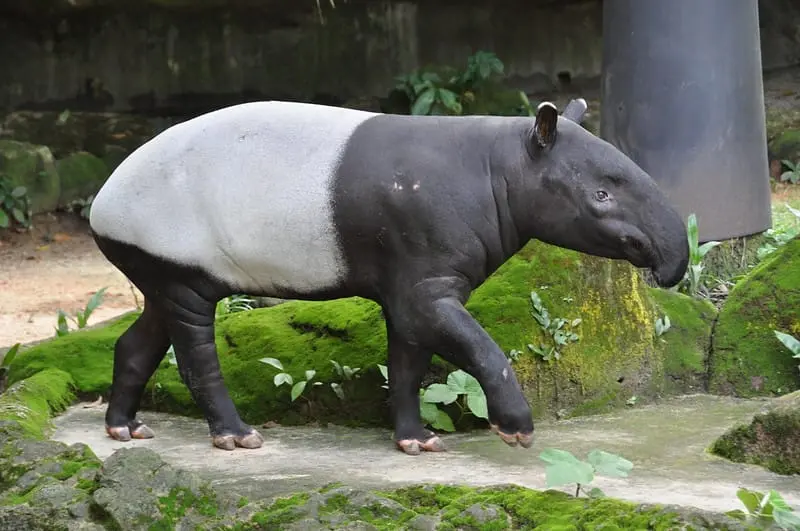The various tapir species
Tapirs are the largest mammals in Central and South America. Although it may not seem so, tapirs are related to donkeys, horses, rhinos, and zebras, which are odd-toed ungulates, but tapirs are the only ones of this group that live only in tropical regions.
Like elephants, tapirs have a small trunk that is highly flexible and can move in all directions, allowing them to grab leaves that would otherwise be out of reach. The size of the trunk varies from species to species; Malayan tapirs have longer snouts and South American tapirs have shorter snouts.
Although they usually live in dry forests, most tapirs spend a lot of time swimming, diving and walking in rivers, feeding on soft vegetation, cooling themselves during the hottest periods and protecting themselves from predators. Tapirs also dive for small fish to eat insects from their bodies. Tapirs also often roll in mud puddles to keep themselves free of parasites and cool.
Adult tapirs are large enough that they have few natural predators, and the thick skin on the back of their necks helps protect them from crocodiles , jaguars, anacondas , tigers, and leopards, but young and weak animals can occasionally be attacked. Despite their size, tapirs can run quite fast and take refuge in the dense, low vegetation of the forest or in water.
There are four recognized species of tapir, and all are listed as threatened or vulnerable on the IUCN Red List of Threatened Species due to hunting for their meat and skins and, more recently, environmental degradation.
South American Tapir (Tapirus terrestris)

It is the largest mammal in Brazil and the second largest in South America, after the Baird’s tapir. It can be found from southern Venezuela to northern Argentina and most of Brazil. It lives in open fields or forests near rivers.
It feeds mainly on palm fruits such as jerivás and buritis. Because it is a great seed disperser, tapirs are very important animals for the conservation and maintenance of palm forests.
The tapir is the only Brazilian animal that has existed since the Quaternary period, when saber-toothed tigers, mammoths and giant sloths still existed. It weighs up to 300 kg (661 lb) and can reach 2.4 m (8 ft) in length. It is distinguished from other species by its mane.
Tapirs have already been extirpated from Rio Grande do Sul and the northeast, as well as several locations throughout the country. Although in decline, their largest populations are concentrated mainly in the Amazon Rainforest and the Pantanal. They are also found in the Atlantic Forest of the Southeast and in the Cerrado.
The main threats are: hunting, deforestation for resource extraction or cattle ranching, fires, infectious diseases from domestic animals and road kill. In addition, tapirs have a low fertility rate, which hinders their reproduction and survival - the gestation of tapirs is two more than a year, and they give birth to only one calf.[^1]
Baird’s tapir (Tapirus bairdii)

Also known as the Central American tapir, it is the largest mammal in Central and South America, weighing no more than 400 kg (880 lb), measuring 2.50 m (8 ft) long and 1.20 m (4 ft) at shoulder height. Its distinctive features are the cream coloration of its face and throat, and a dark patch on each cheek.
Baird’s tapirs are found primarily in wet areas of mangroves, swamps, and humid forests, but to a lesser extent they can be found in drier areas such as gallery forests and mountain forests up to 3,600 m (11,500 ft), but always near water.
They feed mainly on leaves, but grass, flowers and fruits are also part of their diet. They are also excellent seed dispersers.
They live in Central America and in the far north of Colombia. According to the International Union for Conservation of Nature, the Baird’s tapir is considered “vulnerable”. The main causes are hunting and habitat loss.
Mountain tapir (Tapirus pinchaque)

It is the smallest known species of tapir. They are usually about 1.8 m (6 ft) long and no more than 1 m (3 ft) high at the shoulders. They typically weigh between 130 and 250 kg (286 and 251 lb), with females being larger and heavier.
It is the only one that does not naturally inhabit tropical rainforests. They prefer the mountainous forests of Ecuador, Colombia and the far north of Peru. They usually live at altitudes of 2,000 to 4,300 meters, where temperatures often drop below freezing, which is why their fur is thicker.
The main characteristic of this tapir is the white patch around its lips and its thick black coat. Their diet consists mainly of fern leaves and bromeliads. Some palm species depend almost exclusively on these tapirs for seed dispersal. Therefore, where mountain tapirs have become extinct, palm trees will also be drastically reduced.
The main predators of this species are pumas and, less commonly, spectacled bears and jaguars.
It is one of the most endangered species, having been classified by the IUCN as “endangered” since 1996. Although the Baird’s tapir is also classified in such a way, the population numbers of mountain tapirs are even smaller. Their decline is mainly due to hunting and deforestation.
Malayan tapir (Tapirus indicus)

It is the largest tapir species, measuring 2.5 m (8 ft) long and up to 500 kg (1102 lb). It has an unmistakable black and white color. It is the only tapir native to Southeast Asia, inhabiting the southern and central regions of Sumatra (Indonesia) and the peninsula of Malaysia, Thailand, and Myanmar.
They are classified by IUCN as “endangered” due to hunting and habitat loss. In 2014 fewer than 2,500 adult individuals were estimated and that their populations would decline by up to 20% in 24 years. Most remaining populations are isolated in protected areas and discontinued forest fragments, offering little genetic variation
We already know that there are four (or five) species of tapir, three of which live in South and Central America. So why is there a species of tapir in Asia? It seems out of place.

To answer this question we need to understand about the evolution of the species.
The first ancestors of tapirs - such as the heptodonts - appeared during the Eocene and were spread over almost all continents. It was during this time that mammals began to evolve and “dominate” the planet. During this period, the Earth’s climate was quite different - most of the world was warm, temperate and subtropical, with little or no ice present.
As the temperatures decreased, the areas of temperate climate and tropical forests also decreased, and over the years, the tapirs migrated from their original regions (where we now know as Europe and North America) to the south, where the temperate climate still remained. As a result, tapirs that once lived in the Americas now live in South America, and those that once lived in regions close to Europe now live in the nearest tropical regions - Southeast Asia.
Tapirs have always had a very conservative anatomical history and have almost always lived in dense, moist forests. Although they have become larger in size over the past 55 million years, their characteristics, diet, and behavior have remained very similar to those of their ancestors.
Read more:
Cientistas disputam descoberta de nova espécie de anta
In Life’s Race, Tapirs Took a Slow and Steady Pace
